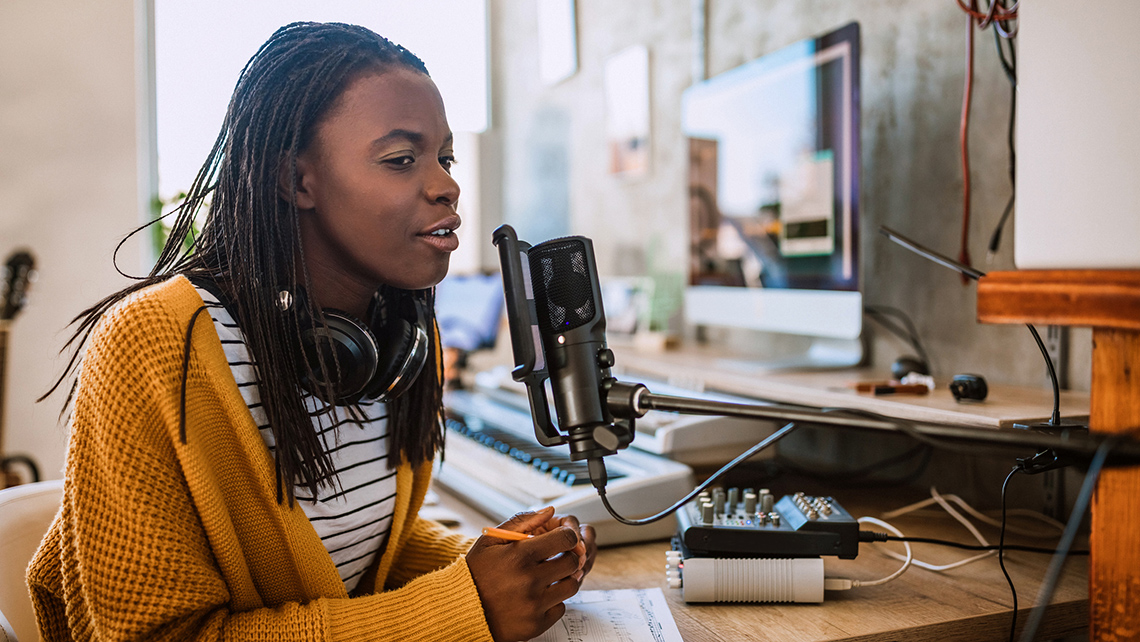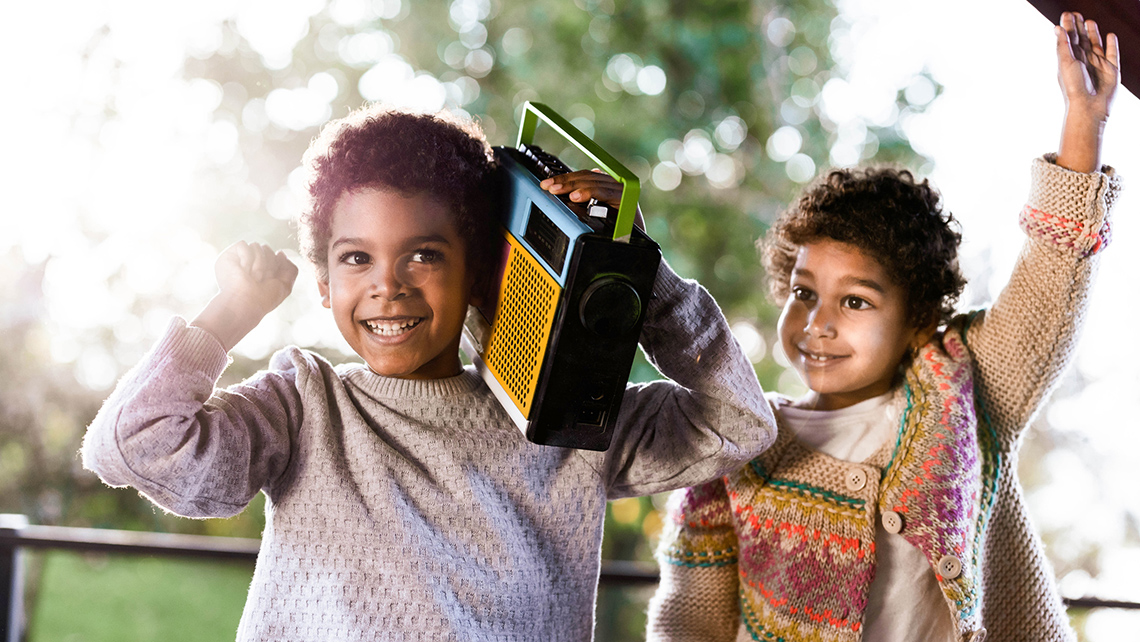Minds On
Today’s vocabulary
Press the following tabs to access today’s vocabulary.
Let’s get started!
Examine the following images.
What do you notice? What are the people doing?
Record your ideas and questions orally, digitally or in writing.
Action
Get ready, get set…
The sound of storytelling

In the Minds On section you explored images of radio shows being created and experienced. There are many different kinds of radio shows today. One kind of radio show is a podcast, which is available on the Internet. Some share music, others share news and stories. These shows are broadcast or shared all over the world. Let’s explore the time when radio broadcasts began.
In the 1920s, radio broadcast became popular. This was before the invention of television. People would gather around the radio for entertainment and news. A popular form of radio entertainment at the time was radio dramas.
What is a radio drama?
A radio drama is created by performers who tell a story using voice, music, and sound effects and then boardcast through a radio. A radio drama does not include any pictures.
Did you know?
Did you know?
Radio dramas were performed all over the world. In Canada, the first radio drama was produced in 1925.
Foley artists

In this black and white photograph from 1940, six different performers known as Foley artists are recording a radio drama. There is a tall microphone standing on the floor in the foreground. The Foley artists are standing in a semi-circle behind the microphone. Some of them are holding instruments, and others are holding objects to create sounds.
Radio studios hired sound artists to create different sounds that were used throughout the story.
The performers who create sound effects for radio dramas are called Foley artists.
Jack Foley was a sound artist in the 1920s who created sound effects for radio dramas. He began working on movies soon after. The artists who use his techniques are called Foley artists.
Foley artists think about how to make sound effects using everyday objects that might be found in the community.
For example, Foley artists will consider what kind of sound effect they need for a specific part in a story and then experiment using different objects. They might do the following:
- ring a bell
- open and close a door
- tap against a surface
- rub two objects together
For radio dramas, the sound effects were created and recorded live.
The magic of making sound
Foley artists are still around today!
For movies, Foley artists create the sounds in a studio. After the Foley artists have completed the sound effects, sound designers and sound mixers help to layer the sounds and ensure that the sounds match the actions. They are added to the movie after it has been filmed. Sound effects can help to tell a story and create a particular mood or feeling for the audience.
Let’s explore a video of Foley artists in the studio. Examine the following video clip “The Magic of Making Sound”.
As you examine the video clip, think about how the sounds are created and respond to the following questions. You may record your ideas orally, digitally, or in writing.
What do you notice the creators are using to make sound effects?
Press the ‘Possible answer’ button to find out what objects were being used to create sound effects.
They used leaves, water, their shoes, and more!
Why might sound effects be important in radio and movies?
Press the ‘Possible answer’ button to learn why sound effects are important.
Sound effects are important in radio and movies because they help tell the story by setting mood or feeling for the audience.
Creating effects
Sound effects can be used to set the mood of a scene or part of a video. Creating the mood is all about deciding how you want the audience to feel.
Explore the following videos and/or sound effects and consider the following question:
How might a Foley sound artist have created the sound effect for each video clip?
Record your ideas orally, digitally or in writing.
Door opening
Explore the following video and audio of a door in motion. How might a Foley sound artist have created the sound effect?
Press the ‘Possible answer’ button to find out how the sound effect could have been created.
For this scene, the Foley artist might open and close an actual door.
A day in the forest
Explore the following video and audio of a forest. How might a Foley sound artist have created the sound effect?
Press the ‘Possible answer’ button to find out how the sound effect could have been created.
For this scene, a Foley artist might use whistles to create bird sounds. For the sound of the wind or tree leaves blowing, they might shuffle paper.
Children playing
Explore the following video and audio of children playing. How might a Foley sound artist have created the sound effect?
Press the ‘Possible answer’ button to find out how the sound effect could have been created.
For this scene, Foley artists might use their shoes to create footsteps and their voices to create the sounds of children playing.
Underwater
Explore the following video and audio of water underwater. How might a Foley sound artist have created the sound effect?
Press the ‘Possible answer’ button to find out how the sound effect could have been created.
For this scene, Foley artists might run their hands through a basin of water to mimic the sound that is created when someone is swimming underwater.
Go!
What is a sound story?

A sound story uses music and instrumentation to create sound effects to accompany a story. Sound effects can be created using voice, body percussion, instruments and/or found sounds in the environment.
The sound story can describe a procedure (e.g., brushing your teeth, or making a craft) or recount an event (e.g., going to the park, or playing a video game).
Imagine that you are a Foley artist. Use sound effects and/or descriptions to create your own sound story.
Student Tips
Student tips
Every story has a structure that includes a beginning, middle and end. The words “First, Next, Then, After, and Finally” can be used to organize the structure.
Explore the following example of a sound story. This story describes the steps someone might take to brush their teeth. How might sounds be created or described to accompany each action?
Record your ideas visually, orally, digitally or in writing.
Complete the Brushing My Teeth Chart in your notebook or using the following fillable and printable document. If you would like, you can use speech-to-text or audio recording tools to record your thoughts.
|
Action |
Sound Effect |
Description of Sound |
|
|---|---|---|---|
|
Time to brush my teeth. First, I take out my toothpaste. |
Unscrewing the cap of toothpaste |
||
|
Next, I put some toothpaste on my toothbrush |
Squeezing the toothpaste onto the brush |
||
|
Then, I start brushing my teeth, up and down and side to side. |
Brushing teeth |
||
|
After I am finished, I spit out the toothpaste. |
Spitting out toothpaste |
||
|
Finally, I take a sip from a cup of water, and rinse out my mouth. |
Rinsing mouth with water |
Press the ‘Activity’ button to access Brushing My Teeth Chart.
Press the ‘Activity’ button to discover a possible answer for the Brushing My Teeth Chart.
Consolidation
Putting it all together
Safety reminder
If using found objects, make sure to ask permission. Place the object back to its spot after you are finished the activity.

Now, it’s your turn to explore the art of Foley and use sound effects and/or descriptions to accompany a story.
Press ‘The Art of Foley’ to access information about creating your own sound effects.
The Art of Foley
To create your own sound effects, you might try one of the following examples or use experiment using other found objects.
- tap using an object to create the sound of footsteps
- turn a doorknob to create the sound of opening a door or object
- let air out of a balloon to create the sound of a windy day or squeezing a tube of toothpaste
- shake a rattle to create the sound of brushing teeth, or rustling leaves
- swirl water in a cup to create the sound of swimming underwater
The sound story can be about an event or a procedure. Examples of procedures might be:
- the rules for a game
- steps someone takes to get getting ready to go outside to play
- steps to follow when creating a recipe
It can be an original creation, or you can choose to re-tell a story that is familiar to you.
Complete the Sound Effects Chart in your notebook or using the following fillable and printable document. If you would like, you can use speech-to-text or audio recording tools to record your thoughts.
|
Action |
Sound Effect |
Description of Sound |
|
|---|---|---|---|
|
First, |
|||
|
Next, |
|||
|
Then, |
|||
|
After, |
|||
|
Finally, |
Press the ‘Activity’ button to access Sound Effects Chart.
Portfolio
Review your learning
Take a moment to review your learning and respond to the following questions:
- What is the art of Foley?
- How do sound effects help to tell a story or create a particular mood?
- Why is it important to provide captions for videos?
- What did you enjoy about creating your own sound story/descriptions?
Record your ideas digitally, orally or in writing. Consider adding your work to your portfolio.
Reflection
How do you feel about what you have learned in this activity? Which of the next four sentences best matches how you are feeling about your learning? Press the button that is beside this sentence.
I feel…
Now, record your ideas about your feelings using a voice recorder, speech-to-text, or writing tool.

